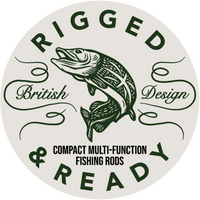Ultimate Guide to Fly Fishing Fly Rods
Whether you’re stalking trout on a quiet chalk stream or casting for salmon in the Highlands, the right fly-fishing fly rod makes all the difference. Fly fishing is about precision, control, and presentation – placing a hand-tied fly exactly where you want it. In this guide, we’ll explain what a fly-fishing fly rod is, what features to look for, and why Rigged and Ready offers some of the most versatile fly-fishing rods for sale in the UK. For beginners and seasoned anglers alike, understanding how to choose rods fly fishing can completely change your experience on the water.
What Is a Fly-Fishing Rod?

A fly-fishing rod is designed to cast lightweight flies using the weight of the fly line rather than the lure. This allows for delicate and accurate presentations across a variety of waters. Some anglers even prefer using a fly fishing pole for small waters where accuracy and simplicity matter more than distance.
Tenkara Rod – A minimalist style of fly fishing without a fishing reel, ideal for small streams and quick setups. Compact and simple, it’s great for travel fishing or as a backup.
Features to Consider When Choosing Rods for Fly Fishing
When selecting your fly-fishing rod, you need to think about the following:
• The water you’ll fish
• The species / size of fish you’re targeting
• Environment (tall banks, trees)
• Your casting style
Length – Shorter rods fly fishing (7–8ft) suit confined streams, while 9–10ft rods offer better reach on rivers and still waters.
Weight Rating – Match the rod’s weight (3wt–8wt) to your quarry – lighter for trout and grayling, heavier for salmon or pike.
Action – Fast action for distance and wind, medium action for all-round use, slow action for delicate work.
Material – Graphite for lightness and responsiveness, fibreglass for a softer, traditional feel.
Portability – multi-section travel fly fishing rods are perfect for anglers who want to take their kit anywhere.
Rigged and Ready Recommendations

Infinite Fly 2-in-1 - A brilliantly versatile travel rod that can be fished as both a 4-weight and a 6-weight. Lightweight, packable, and easy to take anywhere, it offers outstanding value compared to other rods of similar build. Ideal for anglers who want one fly fishing fly rod to handle a variety of situations.
Tips for Using Your Fly Fishing Rod Effectively
• Match your fly fishing rod to the correct line weight for balanced casting.
• Work on timing and smooth acceleration to improve accuracy.
• Keep your rod tip high to manage slack line on the water.
• Rinse and dry after saltwater use and store in a protective case.
Why Buy the Rigged and Ready Fly Fishing Rod
Rigged and Ready offers high-quality, compact, and travel-friendly fly fishing rods for rivers, lakes, and even saltwater.
The Rigged and Ready Infinite Fly 2-in-1 gives you the flexibility of fishing a 4-weight and a 6-weight rod in one package – at a price far lower than many comparable builds, without compromising performance.
Many anglers find that having one fly fishing pole that adapts to multiple situations saves both money and space in their kit.
Frequently Asked Questions
Q) What rod do you use for fly fishing?
Most UK anglers start with a 9ft, 5 or 4-weight rod. These are versatile enough for rivers and still waters, with good distance and accuracy.
Q) What’s the point of a fly-fishing rod?
A fly-fishing rod is built to cast the fly using the weight of the line and not the weight of the lure or end tackle. This allows you to present a tiny, lightweight fly in a way that imitates natural prey.
Q) Why are fly rods so expensive?
A lot of research and engineering goes into producing high-quality fly-fishing rods. The premium materials and precise construction also contribute to the cost.
Q) What is the best fly rod for beginners in the UK?
A 9ft, medium-action, 5-weight fly fishing rod is ideal for UK beginners – easy to learn with, yet capable in varied conditions.
Q) What’s the difference between a fly rod and a regular rod?
A fly-fishing rod casts the line, not the lure. A regular rod relies on the lure’s weight to pull the line through the air.













